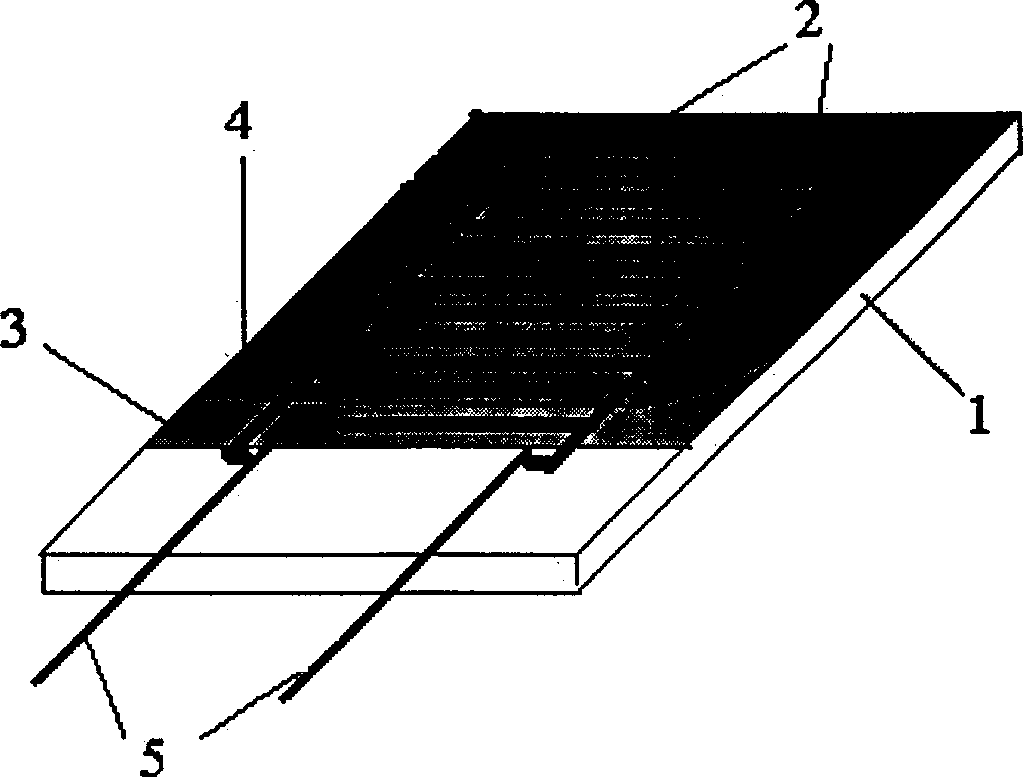Compound polymer resistor type film humidity-sensitive element and its making process
A composite polymer and humidity sensor technology, which is applied in the field of composite polymer resistive thin film humidity sensors, can solve the problems of low high humidity sensitivity, unsatisfactory stability and reliability, poor resistance to high humidity environment, etc. Achieve the effects of good response linearity, high stability, high humidity resistance, and rapid response
- Summary
- Abstract
- Description
- Claims
- Application Information
AI Technical Summary
Problems solved by technology
Method used
Image
Examples
preparation example Construction
[0017] The preparation method of the humidity-sensitive film is to use a dipping machine to immerse the ceramic interdigitated gold electrode in the moisture-sensitive liquid for 1-3 minutes, pull it at a speed of 2-6 mm / s, take it out, dry it naturally at room temperature for 20-60 minutes, and place it for 90 minutes. Heat treatment at ~110°C for 20-40 minutes.
[0018] The moisture-sensitive liquid is (1) polymer polyelectrolyte—sodium polystyrene sulfonate, with a molecular weight of 70,000 to 400,000; (2) additive—sodium carboxymethyl cellulose; the weight ratio of the two is 1:0.5 to 2, It is configured as an aqueous solution with a concentration of 0.2% to 4% by weight.
[0019] The preparation method of the protective film is to use a dipping machine to immerse the ceramic interdigitated gold electrode with a sensitive film in a celluloid acetone solution with a concentration of 1% to 4% by weight for 1 to 3 minutes, and to increase the temperature at a speed of 2 to 6...
Embodiment
[0022] 1) Electrode cleaning
[0023] Soak and clean the ceramic interdigitated gold electrode in absolute ethanol and acetone, and dry it for later use;
[0024] 2) Dip coating of humidity sensitive film and post-treatment
[0025] Dip coating machine is used to immerse ceramic interdigitated gold electrode into polystyrene sodium sulfonate and additive sodium carboxymethyl cellulose aqueous solution (the two are configured to be 0.2%~4% by weight with a weight ratio of 1:0.5~2. % aqueous solution), after 1 to 3 minutes, pull it at a speed of 2 to 6mm / sec, take it out, dry it naturally at room temperature for 20 to 60 minutes, then place it in an oven, and heat treat it at 90 to 110°C for 20 to 40 minutes;
[0026] 3) Dip coating protective film and post-treatment
[0027] Use a dipping machine to immerse the ceramic interdigitated gold electrode with a sensitive film in a celluloid acetone solution (1% to 4% by weight), and pull it at a speed of 2 to 6 mm / s after 1 to 3 mi...
PUM
| Property | Measurement | Unit |
|---|---|---|
| width | aaaaa | aaaaa |
| interdigital gap | aaaaa | aaaaa |
Abstract
Description
Claims
Application Information
 Login to View More
Login to View More - R&D
- Intellectual Property
- Life Sciences
- Materials
- Tech Scout
- Unparalleled Data Quality
- Higher Quality Content
- 60% Fewer Hallucinations
Browse by: Latest US Patents, China's latest patents, Technical Efficacy Thesaurus, Application Domain, Technology Topic, Popular Technical Reports.
© 2025 PatSnap. All rights reserved.Legal|Privacy policy|Modern Slavery Act Transparency Statement|Sitemap|About US| Contact US: help@patsnap.com



